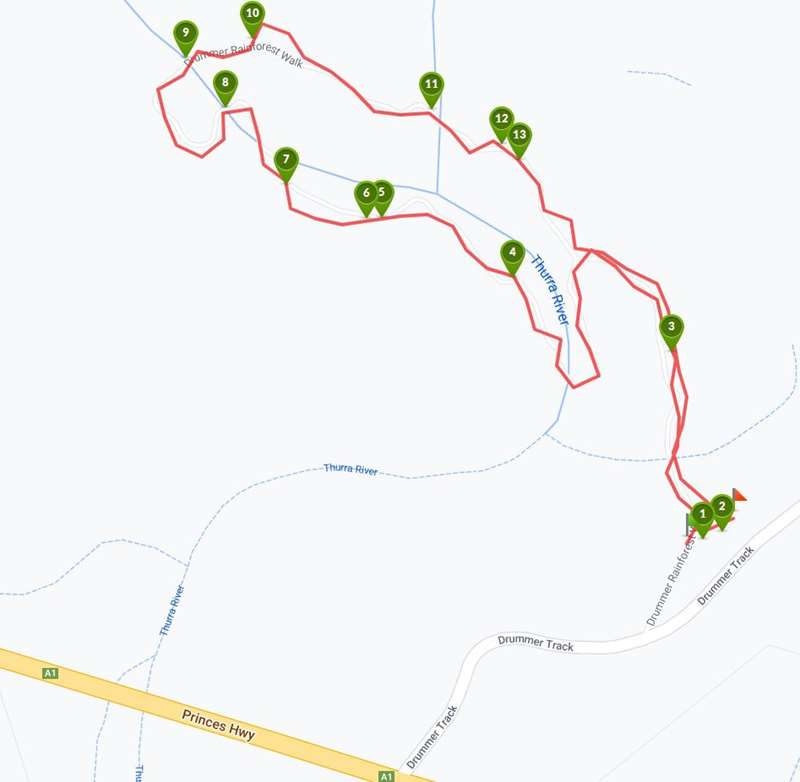Noorinbee - Drummer Rainforest Walk

This lovely 1.2km rainforest walk loops around a section of the Thurra River. Everything is green, moist and lush.
The river is crystal clear and passes under a dense canopy of towering mountain gum, stands of pomaderris, tree ferns and entangled vines. The track meanders along like the river.
The path is a winding combination of compacted gravel, boardwalks and bridges. There are some steps at the beginning.
There is a trailhead sign and no other direction signs are present, but the looping track is pretty clear.
The Drummer picnic area provides car parking, a BBQ and fire pit, picnic tables, a shelter and toilets. Carry your own drinking water.
Access for Dogs:
Pets are not permitted.
Flora and Fauna
We are privileged to see here a remnant of a forest type that was once widespread. Two hundred million years ago, when the climate was much wetter and warmer, dinosaurs roamed through flourishing rainforests. As the climate became cooler and drier, fire became a feature of the landscape. Rainforests became restricted to moist sheltered gullies where fire was inhibited.
Only a small percentage of Australia's original rainforest areas remain. The rainforest environment supports a diverse variety of flora and fauna, including a significant number of plant species that co-exist with many Australian mammals and birds in rainforest ecosystems.
You will be exploring a warm temperate rainforest. In Victoria, warm temperate rainforest is confined to coastal river valleys and associated gully systems from Wilsons Promontory eastwards.
Getting There
The Drummer Rainforest Walk lies just off the Princes Highway, 11km east of Cann River (85km east of Orbost). Access to the walk is clearly signposted off the Princes Hwy. Be aware of log trucks as they also use Drummer Road.
Map of Walking Route

Interactive Map
Points of Interest
1. Drummer picnic area
The picnic area at the start of the walk offers car parking, shelter, picnic tables, gas BBQ, fire pit, and toilets.
2. Woodland birds
Many small birds in the rainforest darted by so fast they remained unidentified. However, the eastern yellow robins certainly did not mind showing themselves.
3. Huge grey mountain gums
This enormous, and to all appearances very healthy, mountain gum has been hollowed out by fire inside. Step right in. Mountain Grey Gum ( Eucalyptus cypellocarpa ) is found scattered throughout the rainforest. This species is found in dry and wet eucalypt forest as well as the transitional zone where the rainforest merges with drier eucalypt forest types. The Grey Gum here has been scarred by the Ash
Wednesday fires in 1983. The hollow that has been produced provides shelter for possums, birds, bats, insects and other fauna.
4. Magnificent tree ferns
The dense vegetation and tall tree ferns give the walk a prehistoric feel. The canopy in a rainforest is very dense. Unlike eucalypts, rainforest trees hold their dark green leaves horizontally to catch the sunlight; thus very little light reaches the forest floor. This provides excellent conditions for shade loving ferns, mosses, lichens and liverworts. Vines climb towards the precious sunlight.
5. Every surface supports life
This tree is covered in a layer of tendril like growth.
6. A close up
The moss like covering.
7. Fruiting vines
It is fascinating to see vines reaching into any area open to light. There are a number of vines striving to reach the light at the top of the canopy. In late spring you may detect the heavy perfume of the White Milk Vine flowers. This is to attract moths and butterflies, which feed on the nectar and assist in pollination of the flowers. Like many rainforest plants, these vines produce fleshy fruits which are a food source for the many types of fauna which inhabit the rainforest.
8. Thurra river
The transparent waters of Thurra River were as smooth as glass.
9. Footbridges
Footbridges cross the river at several points. Approaching the footbridge, walk slowly and look carefully. Many small creatures are extremely well camouflaged in the streamside vegetation. Gippsland Water Dragons lie perfectly still on logs or low branches near the water. They prey on fish, frogs and small mammals. At the slightest hint of danger, they disappear with a splash into the water.
10. Epiphytes
Many trees are host to prolific parasitic epiphytes.
11. Boardwalks
Boardwalks are strategically placed to protect embankments and ground level vegetation.
12. Rainforest recycling
Nothing goes to waste. A massive tree undergoing metamorphosis. When walking in the rainforest, not only should you look up and admire the beauty of the trees and flora, but also look down at the forest floor. Nutrients are recycled quickly in the rainforest. The leaf litter layer is like a store where everything is returned after use for recycling. Bacteria, fungi, native snails and worms break down the dead plant and animal material and return it to the soil to begin the life cycle of another plant. Lyrebirds and Eastern
Whipbirds help too. As they scratch through the leaf litter searching for food, they turn the litter layer over and aerate it, thus assisting in the composting process.
13. Mosses and fungi
Everywhere around you mosses and fungi are at work breaking down larger bodies of vegetation. Everything in the rainforest is connected and nothing is wasted. Insects eat the plants, they, in turn, are eaten by small birds and animals, with larger fauna preying on these smaller species. Other creatures and insects help break down droppings and any remaining carcasses. Their nutrients are returned to the soil to begin the whole life cycle once more. If any part of the cycle is disrupted, it will affect the whole system.
Location
Cnr Drummer Track and Princes Highway, Noorinbee 3890 View Map
Web Links
→ Drummer Rainforest Walk Brochure (PDF)
→ Drummer rainforest walk (Walking Maps)








